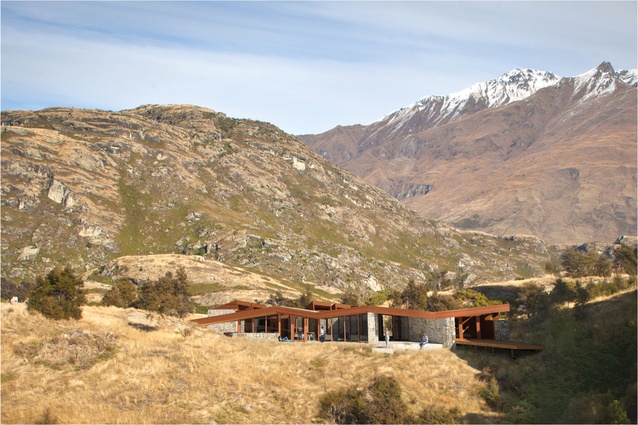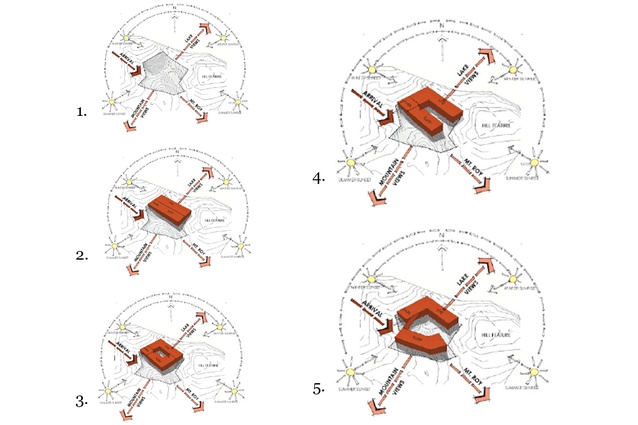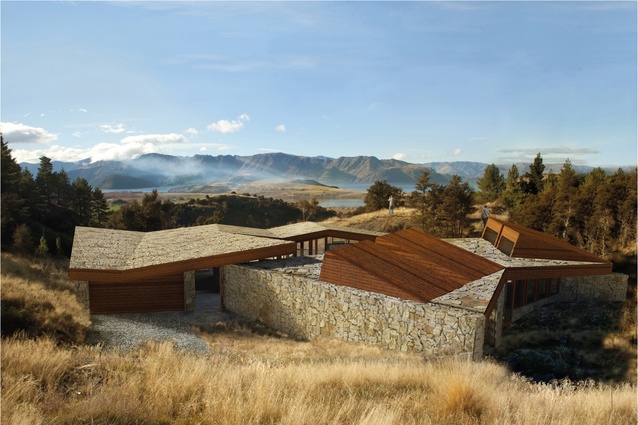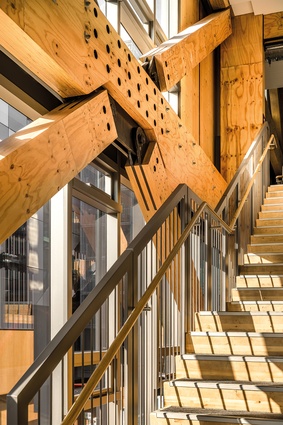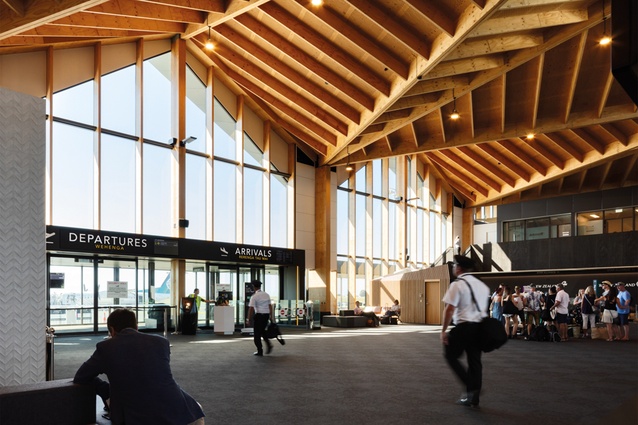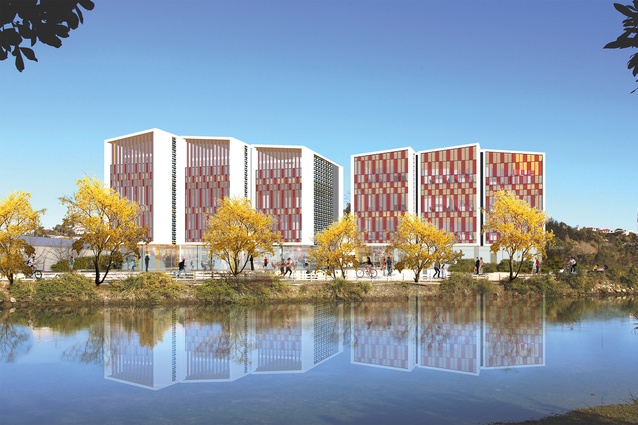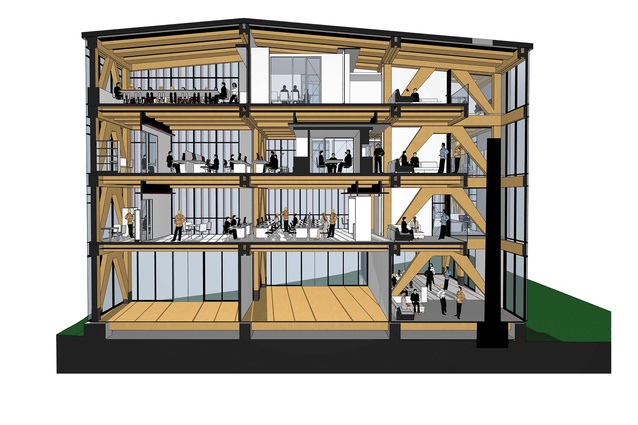A call to action
Abigail Hurst explores what it takes for architects to get real about the climate crisis.
Australia’s devastating 2019–2020 bushfire season was a regional wake-up call to the link between climate change and increased extreme events. However, any actionable learnings from this tragedy (i.e. global warming boosted the bushfire risk by at least 30 per cent), have been eclipsed by the COVID-19 pandemic.
Our country’s reaction has shown we can all make dramatic change to the way we live, work and play when needed. We are now borrowing billions from future generations for our recovery. But, what of the other, much deeper emergency facing our planet: the continuing rise of temperatures and carbon-dioxide concentration? The COVID-19 lockdown gave us an eerie glimpse into what fighting the climate crisis might look like – cities no longer belching pollution, empty roads and clear skies.
These lockdowns around the world show how it is possible to dramatically drop atmospheric C02 concentrations. Yes, says Bill McKibben, founder of the grassroots climate campaign 350.org and writer of ‘The Climate Crisis’, The New Yorker’s newsletter. But, it’s complicated. McKibben points out that April 2020 has tied for the hottest April on record, and that there is a high probability this year will become the hottest one ever.
Lockdowns around the globe caused dramatic carbon-dioxide emissions reductions – an incredible 17 per cent drop in daily emissions in early April. The International Energy Agency estimates this will equate to around an eight per cent emissions reduction this year. Great, but it’s really just a drop in the bucket. As McKibben explains, once we emit carbon dioxide, the molecule stays in the atmosphere, trapping heat for a century or more.
We face two questions. The first: can we maintain that eight per cent drop as countries come out of lockdown? The second, says McKibben, outlines the enormity of the task ahead – can we drop CO2 emissions another eight per cent each year for much of the next decade? That’s what it will take to meet the temperature targets set at the Paris UN Climate Change Conference in 2015.
For many, the answer is simple. We owe it to our children to make this planet a place where they can thrive. We should take this opportunity to build momentum behind the current state of urgency for our climate and collective futures. Everyone, including architects, needs to do what they can.
New Zealand’s Architects Declare letter has been signed by over 100 practices since it was launched at the end of 2019. Largely based on the declaration by architects in the UK, the agenda highlights climate breakdown and biodiversity loss as the two most serious issues of our time and seeks to form a common will: a commitment to meet the needs of our society without breaching the Earth’s ecological boundaries.
Yet, much more work needs to be done if it is to be our profession’s turning point. Eleven aims are listed – some that are quite specific and others that are rather vague. With no method of accountability proposed, clear steps for action or timeframe, we need to figure out what we should actually do. This is not the time for a pep-talk – we have had 30 years of those – this is a call to action.
Since the Industrial Revolution, humans have increased the amount of carbon dioxide in the atmosphere by more than a third. Temperature changes, historically taking thousands of years, are happening over the course of decades.1 Experts estimate that at the end of this century, if current trends continue, the globe’s average surface temperature will be 3–4 degrees Celsius warmer than it was before the Industrial Revolution. This will result in melting glaciers, sea-level rise, uninhabitable land areas, and catastrophic destruction to global societies and economies.2 These scientists have said we only have until 2030 to make a meaningful change in our carbon emissions and avoid this ruinous fate, although parts of our climate system may be already past tipping point.3
Carbon and practice in New Zealand
Many internationally renowned architecture practices have also declared a Climate and Biodiversity Emergency. The Norwegian firm Snøhetta stands out among them, pledging within the next 20 years to only design carbon-negative buildings. It plans to follow a cradle-to-cradle approach, meaning its projects will generate more energy than they consume over their entire lifetime, including decommissioning at the end of a building’s life. This may seem like an unattainable goal for the everyday small and mainly residential architect in New Zealand, but, we need to take Snøhetta’s torch of inspiration for ourselves and creatively adapt our behaviour and design philosophies to our own projects and landscapes.
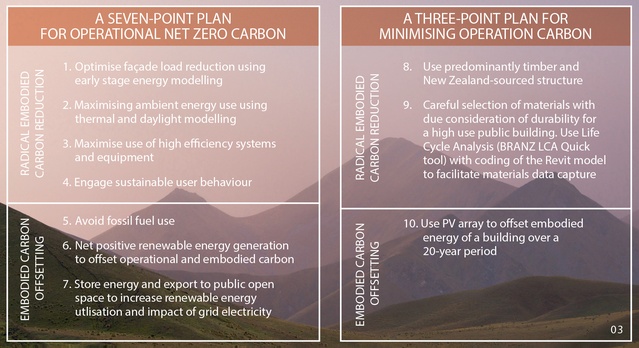
eCubed’s David Fullbrook, an environmentally sustainable design (ESD) specialist based in Auckland, has worked with many architects throughout our country. He says we need a focus beyond Architects Declare and that focus must be on carbon.4 “It is worthwhile thinking proportionally, (that) the New Zealand building sector uses 20 per cent of greenhouse gas emissions directly,” says Fullbrook, compared to about 40 per cent overseas. This is because our agricultural emissions are nearly 50 per cent of our total emissions, compared to 11–12 per cent globally, giving us a unique set of environmental circumstances. Another reason is 84 per cent of our country’s electricity generation was from renewable sources in the year ending 2018,5 making us one of the most sustainable energy producing countries in the world.
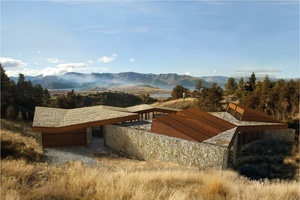
Given our largely renewable source of energy, it makes sense to prioritise reducing the embodied carbon in a building over its operational carbon. We also need to optimise use of our locally available materials and technology. Timber is the way of the future here. It translates to negative embodied carbon, and goes a huge way to helping those carbon calculations stack up.
As architects, we have influence over both operational and embodied carbon emissions in every building that we design, but we are not utilising the tools and solutions available to us. eCubed proposes a 10-point operational carbon reduction strategy for buildings, integrating sustainability into all design projects.6 This strategy targets both embodied and operational carbon through consideration of a building’s façade, careful selection of materials, a combination of natural and mechanical heating and cooling, and engaging sustainable user behaviours.
RTA Studio’s Richard Naish says the firm’s C3 House has “attempted to win on both sides”, using many of the principles of Fullbrook’s strategy by targeting the two carbon emission types. Not yet built, this project won the Future Projects: House category at the World Architecture Festival in 2012. The proposed one-storey, four-bedroom family home, located near Wanaka, utilises locally sourced timber, stone and rammed earth materials to create a net zero of embodied carbon. Operational carbon is minimised with careful orientation on site, sun control, natural cross ventilation and heating from a ground source heat pump. The building can also be recycled at the end of its life, with its disassembly and re-use of materials envisioned at design stage.
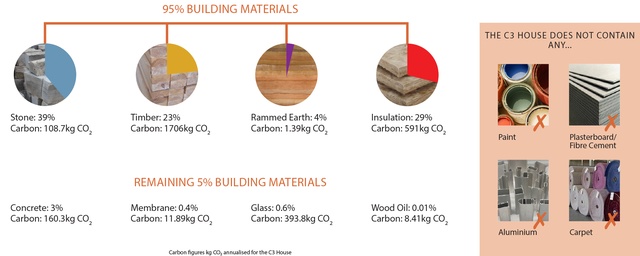
More recently, RTA Studio, in collaboration with Irving Smith Architects, designed the new Scion campus in Rotorua. For a Crown Research Institute that specialises in development of the forestry industry, it is fitting that major timber innovation has been a key part of the project. A three-storied, timber-engineered building with ventilated glass façade, the building shows us a new way of doing multi-storey timber – with a diagrid structural system and no steel in joining members.
There have been a number of small multi-storey buildings completed in the past year that push the bounds of timber technology possibilities in construction: Nelson Airport’s Terminal by Studio Pacific Architecture (with a rough approximation of 300 tonnes of C02 total embodied in the building)7 and the University of Canterbury’s Beatrice Tinsley building by Jasmax, DJRD Sydney and Royal Associates Architects in association (a four-storey construction that utilises timber moment frames and cross braces, as well as a timber double T cassette system floor).
For New Zealand, part of the solution to this crisis includes further embracing timber technologies, learning from those experimenting in the field, and creating an open-source knowledge base. However, as with most complex problems, there is no cookie-cutter solution
to achieve sustainable outcomes.
Richard Naish, director of RTA, has no preconceived idea of what a project should look like, although common forms have developed in his studio’s history as a result of the investigative design process. Narrower, more broken-up buildings are a pattern, not because they look cool (though they do), but because the shapes make sense from a natural, passive-design perspective. Although this may result in more external surface area, in Naish’s experience, it pays off: “There is always a complex formula to create a building. There is a system of different parts that push and pull each other to create an ultimate outcome.” Incorporating sustainability in design is not about ticking boxes but seeing the project for the beast that it is and evaluating its interconnected parts each step of the way.

Rating systems and tools
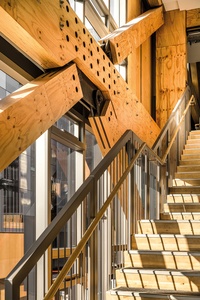
Speaking of ticking boxes, what about rating systems like New Zealand Green Star and Homestar? Fullbrook says systems like these need to be updated and re-designed with more weight given to the categories of carbon and biodiversity, and refined to suit New Zealand’s current environment. These certifications may be of value to the client, and have a role to play, but they are also quite prescriptive. While there is something to be said for making environmental performance visible and tangible, the rating systems don’t necessarily answer many questions.
“It’s a lazy one. The outcomes don’t really generate what we need to generate”, says Fullbrook. “The problem with Green Star is everyone tries to do it at the lowest possible cost.” Other tools being developed and existing software, such as Revit, enable a lifecycle analysis of a building as it develops, making data easier to obtain for analysis. However, we need to be thinking beyond number games if we are really going to turn the tide.
There is a change in demand occurring internationally, where progressive developers who had pursued the highest Leadership in Energy and Environmental Design (LEED) ratings are now asking architects for something beyond that – to look at the integrated, holistic design question. Bjarke Ingels, Danish architect of BIG (Bjarke Ingels Group), has written a research paper on ‘Engineering without Engines’,8 proposing that buildings should be less reliant on machines to condition habitable internal environments, and learn from vernacular architecture. Environmental control through the use of machinery has in the last 100 years separated us from nature, fooled us to think we can defy it: and perhaps we have, but only temporarily. Now, we are seeing the price paid, and need to reconnect our thinking of buildings as part of a greater ecosystem. Our buildings are never separate from their physical, social and financial contexts, and we need to realign the role of the architect to being a designer of these ecosystems.
Regeneration
Best practice is not carbon zero, or having no impact. We need to go beyond neutrality. Michael Pawlyn from the UK Architects Declare movement says we urgently need to look at what it means to be regenerative.9 Practicing regeneration is to recognise underlying patterns in nature and include our projects (the people and the buildings) as part of caring for these systems, to co-develop with the surrounding environment. Stemming from the principles of permaculture, this means having deep conversations with clients at a project’s inception.
A holistic approach towards projects and resources is not foreign to our country. There is much to be learnt from tangata whenua and their beliefs held towards economic, environmental and social responsibilities. These aspects of our health and ecosystem are intrinsically linked and contain mauri, a measure of life-force and the binding between what is physical and spiritual.10 Although there are different views across iwi, mauri is a common concept gaining recognition and starting to be integrated within regional plans by local councils, including the development of a strategy called the Mauri Model. The model is based on four circles that represent interactive aspects of the health of our ecosystem.
The impact of decisions is assessed by the weighting of these symbolic circles, recognising the importance of the environment for our continued existence, our identity and community (and economic wellbeing, too). Adopting this type of thinking towards our projects and planning calls us to our roots and provides a framework for an outward focus.
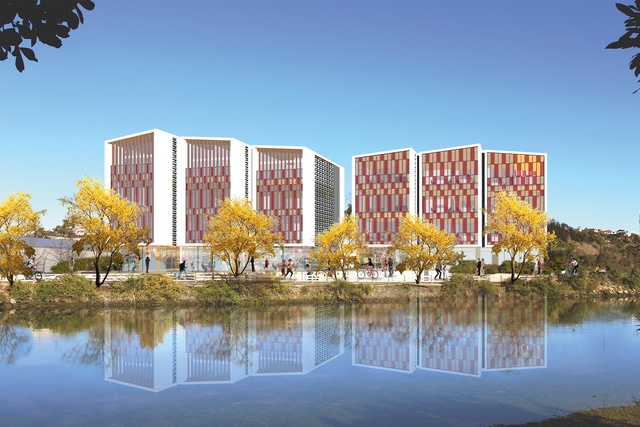
In a similar vein, Irving Smith Architects has been developing a new administration building for Wakatū Incorporation, sited prominently in central Nelson adjacent to the Mahitahi River. Jeremy Smith, a director at Irving Smith Architects, says it has been refreshing to work with a client willing to ask the big questions. Wakatū has a long-sighted vision, with a 500-year plan that prioritises the wellbeing of people and the environment. The proposed building is a four-storey timber structure, with a ground floor that is able to be raised during the building’s lifetime, if needed, due to sea level rise. Utilising local timbers and materials, the resulting form is striking, designed with resilience to future change in mind. Its presence will bring vibrance to the connection between the city and the river for the benefit of all.
The call for action
Since the UK Declaration, the Royal Institute of British Architects (RIBA) declared a state of climate emergency and committed to a five-year plan of action. This action plan includes making sustainable practices standard, improving government policy by lobbying and reducing RIBA’s own carbon footprint.11 The NZIA has, so far, included Environmentally Sustainable Design as an item to each stage of design in contract agreements, and has included sustainability as part of its criteria for its awards programme. But, there is more to be done if we are going to focus on a green recovery beyond the COVID-19 pandemic.
Our thinking needs to shift to timeframes that are much longer, even in the midst of economic decline. Because, if we don’t start now, climate change will create an even greater loss of economy, wellbeing, lives and industry for decades to come. At a grass-roots level, we need up-skilling. Training at a tertiary level is good but we cannot rely on the younger generation to fix all of our problems. Targeted seminars, CPD events and resources will educate existing practitioners and help us all to form steps towards this goal and encourage us to become innovative in our projects.
But, architects also need a top-down strategy from governmental bodies, a safety net for regulations. 2019 saw the passing of the Climate Change Response (Zero Carbon) Amendment Bill, a framework from which our country will implement policies on climate change, contributing to the Paris Agreement. A new 2050 greenhouse gas reduction target exists but we now need to use our influence to push for clear, updated legislation, able to be applied to the building industry, that we can act on.
Only 100-odd NZIA practices of the over 700 practices registered in New Zealand have signed the declaration to date. Hardly a ringing endorsement. It’s unlikely the majority of us are sceptical of climate change. The lack of action is more likely due to indecision coupled with the many other concerns of running a business. However, being in a state of emergency means we can no longer sit on our laurels and put off making any change to our own practices (individual or corporate). The fragility of our plans has been revealed against the larger forces of nature, but so too has our ability to recover from complex threats. The longer we put off the Climate and Biodiversity Emergency, the bigger the collective price we will pay. It is no longer a luxury to be sustainable, it is a necessity. Our thinking and our work must be nimble in this climate. Let’s not just declare, let’s act.
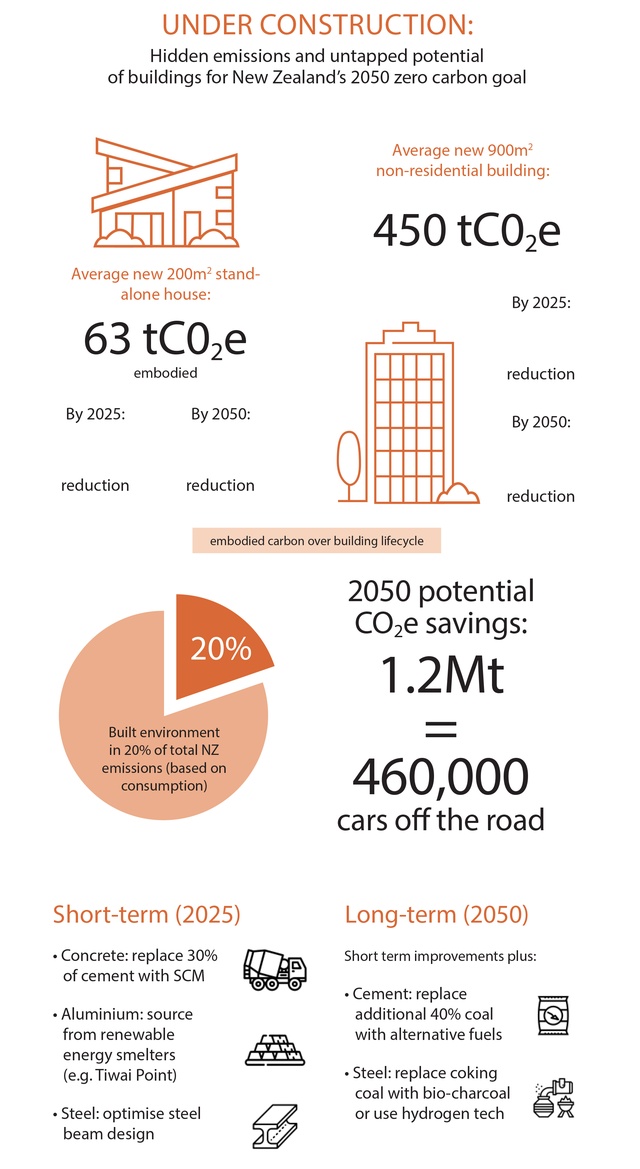
1 nationalgeographic.com/environment/global-warming/global-warming-overview/
2 bbc.com/earth/story/20151130-how-hot-would-the-earth-get
3 insideclimatenews.org/news/27082019/12-years-climate-change-explained-ipcc-science-solutions
4 Fullbrook, David (eCubed Ltd), Interview, 3 April 2020
5 Energy in New Zealand 2019, publication by the Ministry of Business, Innovation & Employment, October 2019
6 e3bw.co.nz/journal/2020/1/8/a-new-decade
7 Smith, Jeremy, ‘Meeting Under Chevron Hoods’, Architecture NZ, March/April 2020
9 dezeen.com/2019/10/07/michael-pawlyn-architects-declare-interview-regenerative-architecture/
10 Tangata Whenua Perspective on Sustainability using the Mauri Model, Dr Kepa Morgan.

